Quick Look
Grade Level: 8 (7-9)
Time Required: 1 hours 45 minutes
(can be split into different sessions)
Expendable Cost/Group: US $30.00 This expendable cost covers only the items that may require replacement after extensive use, including laser trip sensor kit with alarm and sticky tack. See the Materials List for additional non-expendable supplies.
Group Size: 4
Activity Dependency:
Subject Areas: Physics, Science and Technology
NGSS Performance Expectations:

| MS-ETS1-1 |
| MS-ETS1-2 |
Summary
Students use simple household materials, such as PVC piping and compact mirrors, to construct models of laser-based security systems. The protected object (a "mummified troll" or another treasure of your choosing) is placed "on display" in the center of the modeled room and protected by a laser system that utilizes a laser beam reflected off mirrors to trigger a light trip sensor with alarm.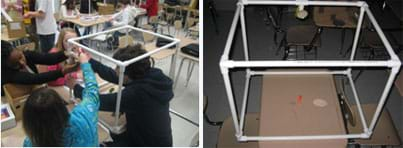
Engineering Connection
While the students are building their own alarm system it is important for them to consider how mechanical and civil engineers would go about building this system in reality. Lasers are used in manufacturing warehouses where industrial products are created by mechanical engineers. They can be used for accurate and efficient cutting and welding purposes. The PVC pipe the students use could be substituted with a metal that would have been cut with a laser! Students are prompted to think like engineers in the post-activity assessment questions 5 and 6, considering the real-world means of preparing materials and safety hazards when using lasers.
Learning Objectives
After this activity, students should be able to:
- Apply laser properties to construct a security system.
- Understand and describe how the system works.
- Understand how a beam of light can control other devices.
This activity also meets the following Tennessee Foundations of Technology educational technology content standards: 2.1, 3.2, 3.3, 3.4, 5.2, 5.3, 7.1, 7.2 and 7.3
This activity also meets the following International Society for Technology in Education (ISTE) standards: 1.1, 1.2, 2.2, 2.3, 3.1, 3.2, 6.1, 6.2; see http://www.iste.org/AM/Template.cfm?Section=NETS
Educational Standards
Each TeachEngineering lesson or activity is correlated to one or more K-12 science,
technology, engineering or math (STEM) educational standards.
All 100,000+ K-12 STEM standards covered in TeachEngineering are collected, maintained and packaged by the Achievement Standards Network (ASN),
a project of D2L (www.achievementstandards.org).
In the ASN, standards are hierarchically structured: first by source; e.g., by state; within source by type; e.g., science or mathematics;
within type by subtype, then by grade, etc.
Each TeachEngineering lesson or activity is correlated to one or more K-12 science, technology, engineering or math (STEM) educational standards.
All 100,000+ K-12 STEM standards covered in TeachEngineering are collected, maintained and packaged by the Achievement Standards Network (ASN), a project of D2L (www.achievementstandards.org).
In the ASN, standards are hierarchically structured: first by source; e.g., by state; within source by type; e.g., science or mathematics; within type by subtype, then by grade, etc.
NGSS: Next Generation Science Standards - Science
| NGSS Performance Expectation | ||
|---|---|---|
|
MS-ETS1-1. Define the criteria and constraints of a design problem with sufficient precision to ensure a successful solution, taking into account relevant scientific principles and potential impacts on people and the natural environment that may limit possible solutions. (Grades 6 - 8) Do you agree with this alignment? |
||
| Click to view other curriculum aligned to this Performance Expectation | ||
| This activity focuses on the following Three Dimensional Learning aspects of NGSS: | ||
| Science & Engineering Practices | Disciplinary Core Ideas | Crosscutting Concepts |
| Define a design problem that can be solved through the development of an object, tool, process or system and includes multiple criteria and constraints, including scientific knowledge that may limit possible solutions. Alignment agreement: | The more precisely a design task's criteria and constraints can be defined, the more likely it is that the designed solution will be successful. Specification of constraints includes consideration of scientific principles and other relevant knowledge that is likely to limit possible solutions. Alignment agreement: | All human activity draws on natural resources and has both short and long-term consequences, positive as well as negative, for the health of people and the natural environment. Alignment agreement: The uses of technologies and any limitations on their use are driven by individual or societal needs, desires, and values; by the findings of scientific research; and by differences in such factors as climate, natural resources, and economic conditions.Alignment agreement: |
| NGSS Performance Expectation | ||
|---|---|---|
|
MS-ETS1-2. Evaluate competing design solutions using a systematic process to determine how well they meet the criteria and constraints of the problem. (Grades 6 - 8) Do you agree with this alignment? |
||
| Click to view other curriculum aligned to this Performance Expectation | ||
| This activity focuses on the following Three Dimensional Learning aspects of NGSS: | ||
| Science & Engineering Practices | Disciplinary Core Ideas | Crosscutting Concepts |
| Evaluate competing design solutions based on jointly developed and agreed-upon design criteria. Alignment agreement: | There are systematic processes for evaluating solutions with respect to how well they meet the criteria and constraints of a problem. Alignment agreement: | |
International Technology and Engineering Educators Association - Technology
-
Students will develop an understanding of the attributes of design.
(Grades
K -
12)
More Details
Do you agree with this alignment?
-
Students will develop an understanding of engineering design.
(Grades
K -
12)
More Details
Do you agree with this alignment?
-
Make two-dimensional and three-dimensional representations of the designed solution.
(Grades
6 -
8)
More Details
Do you agree with this alignment?
-
Modeling, testing, evaluating, and modifying are used to transform ideas into practical solutions.
(Grades
6 -
8)
More Details
Do you agree with this alignment?
-
Apply the technology and engineering design process.
(Grades
6 -
8)
More Details
Do you agree with this alignment?
-
Analyze examples of technologies that have changed the way people think, interact, and communicate.
(Grades
6 -
8)
More Details
Do you agree with this alignment?
Materials List
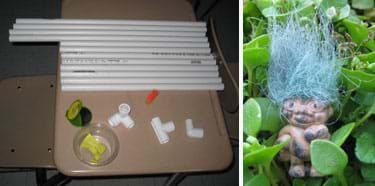
Each group needs:
- 20 feet (6 m) of half-inch PVC pipe cut into eight 18-inch (~45 cm) and four 24-inch (~60 cm) sections (PVC pipes available at hardware stores)
- 8 three-way PVC pipe corner connectors
- 6-8 PVC pipe "snap-T" connectors and/or 90-degree street elbows (for attaching mirrors)
- 6-8 compact mirrors (available at discount, drug or gift stores for ~$1.20 each, example source: CTA https://www.goodybeads.com/store/products/Z003407.htm)
- 1 laser trip sensor alarm kit
- sticky tack (reusable adhesive), 1 package (available in stationery/school supplies section at discount, office supply and drug stores)
For the entire class to share:
- (optional) rubber troll doll (available at toy stores) or make up your own treasure to protect
Note: A US$ 36 per group cost for non-expendable items includes PVC pipe, pipe connectors, 90-degree elbows, and compact mirrors. To reduce costs, groups may share supplies.
Pre-Req Knowledge
Basic understanding of light properties (especially reflection) and how lasers work, as provided in this unit's lessons 2 and 3, Learning Light's Properties and Laser Types and Uses, and their associated activities. An understanding of the engineering challenge and infomercial expectations outlined in lesson 4, Security System Design.
Introduction/Motivation
At the beginning of this unit, we received a challenge from our principal to create a security system to protect a valuable troll found on the school grounds. After being presented with this engineering challenge, we explored the necessary light and laser scientific properties so we have the information needed to devise a solution.
(This activity begins the Test Your Mettle phase of the legacy cycle.) Today, you will design and build a working security system using only the materials available, which shows whether you understand the properties of light and lasers and are able to apply these concepts to solving the challenge. Following the building stage of our challenge, you will test your designs and have an opportuniry to re-design and re-test. At the end, you will each answer questions to be turned in for a grade.
After this activity, we will Go Public. To do this, your team will create an infomercial to convince us that you have created the most reliable and cost-effective design.
Procedure
Before the Activity
- Gather materials and bundle them in groups for student use.
- Assign costs for all materials (i.e., unit price) so students can determine final cost.
- Arrange for level working areas for students to construct their models.
With the Students
- Describe the assignment to students and explain the materials provided.
- Divide the class into groups of three or four students each.
- Have students sketch their designs down on paper before they build.
- Give enough time for students to construct a working model of a laser trip sensor system.
- Have students test their designs and re-design if necessary.
- Ensure students are keeping track the cost of their designs.
- Have students share their designs and compare other team's designs and discuss how well their solutions meet the challenge requirements.
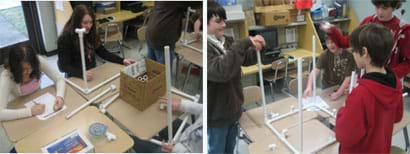
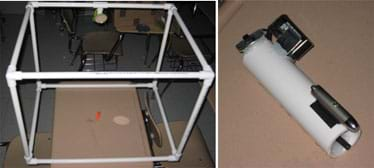
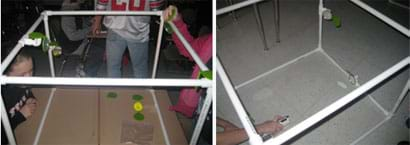
Vocabulary/Definitions
laser: A device that emits coherent light through a specific mechanism.
light sensor: A device used to detect the presence of a light source.
model: A scaled representation of an actual system.
Assessment
Post Activity Assessment
Summary Written Test: Have each student answer the following questions and submit them for grading. In addition to the design process, these questions address the Test Your Mettle phase of the legacy cycle.
- Why did you select the type of laser you used in your security system design?
- What other technologies might make use of the laser you have used in this design?
- If you were to change roles and act as the thief, how could you outsmart your design?
- What is the purpose of the trip sensor?
- If you were a mechanical engineer building this system on a life-size scale using a metal frame, what type of machinery would provide the most accurate cuts?
- As an engineer, it is important to consider the safety of the system you have created; could anyone be harmed once your system is implemented?
Activity Extensions
If students show an interest in security systems, contact a local security system consultant to demonstrate and discuss various systems.
Have students create advertising commercials that sells potential buyers on their systems.
Activity Scaling
- For lower grades, provide more time for construction.
- For upper grades, provide less time for construction, using it as a real-world limitation.
Subscribe
Get the inside scoop on all things TeachEngineering such as new site features, curriculum updates, video releases, and more by signing up for our newsletter!More Curriculum Like This

Through two classroom demos, students are introduced to the basic properties of lasers through various mediums. Students will gain an understanding of how light can be absorbed and transmitted by different mediums.

Students apply everything they have learned about light properties and laser technologies to designing, constructing, defining design limitations and presenting laser-based security systems that protect the school's mummified troll. In the associated activity, students "test their mettle" by constru...

Students research particular types of lasers and find examples of how they are used in technology today. Teams present their findings by means of PowerPoint presentations, videos or brochures.

Students learn the basic properties of light — the concepts of light absorption, transmission, reflection and refraction, as well as the behavior of light during interference. Lecture information briefly addresses the electromagnetic spectrum and then provides more in-depth information on visible li...
References
Dictionary.com. Lexico Publishing Group, LLC. Accessed August 7, 2008. (Source of vocabulary definitions, with some adaptation)
Copyright
© 2013 by Regents of the University of Colorado; original © 2008 Vanderbilt UniversityContributors
Terry Carter; Meghan MurphySupporting Program
VU Bioengineering RET Program, School of Engineering, Vanderbilt UniversityAcknowledgements
The contents of this digital library curriculum were developed under National Science Foundation RET grant nos. 0338092 and 0742871. However, these contents do not necessarily represent the policies of the NSF, and you should not assume endorsement by the federal government.
Last modified: October 4, 2019










User Comments & Tips